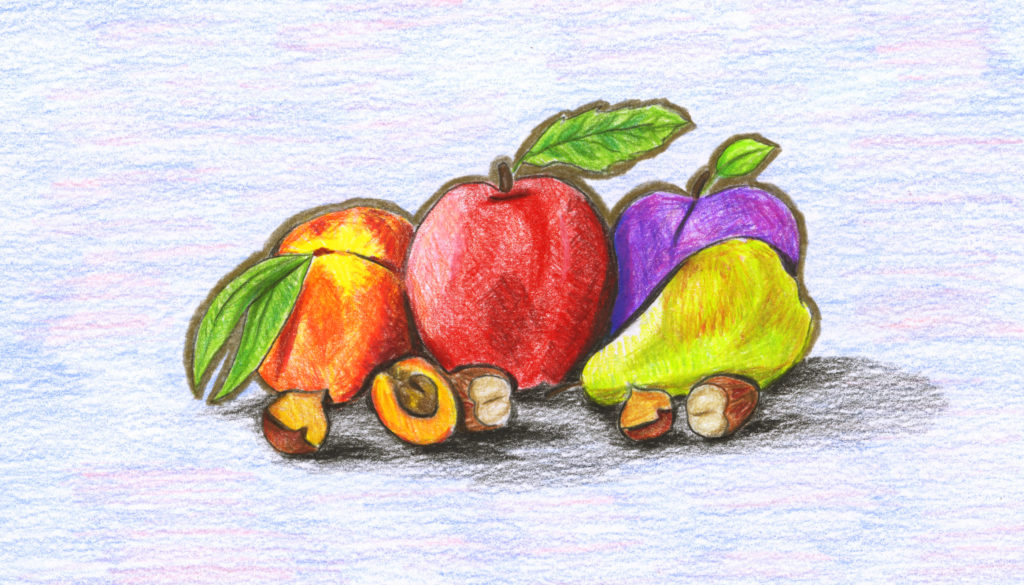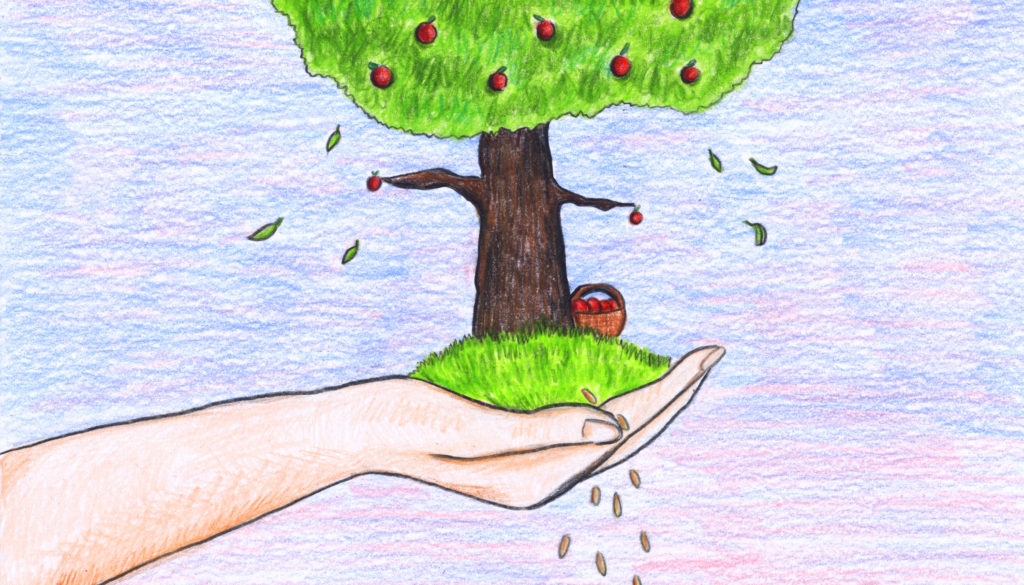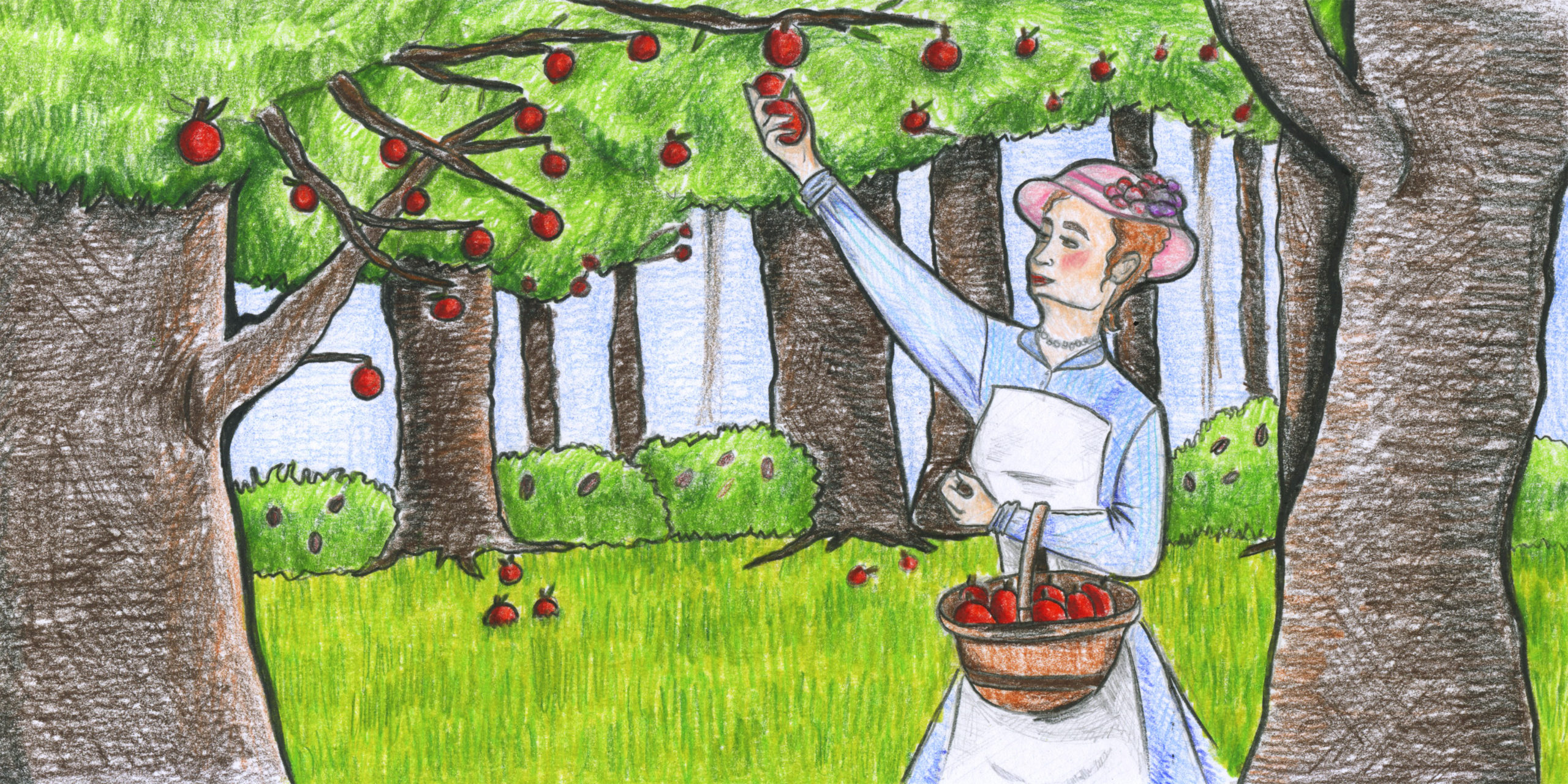Excerpted and edited from Taming Fruit: How Orchards Have Transformed the Land, Offered Sanctuary, and Inspired Creativity, by Bernd Brunner, available November 2 from Greystone Books. Excerpted by permission of the publisher.
The orchards of past times that have survived — in physical form or at least recorded in written documents — are those that belonged to kings and queens, the noble class, and religious orders. But while these estates were impressive, they did not represent the typical orchards that provided most people with fruit. As far back as the Middle Ages, networks of orchards surrounded many of central Europe’s villages and towns. In many cases, they were part of or located near vegetable or kitchen gardens. Crops such as potatoes, turnips, corn, or grasses grew in the shade of the trees and both crops and fruit were harvested by hand in the fall.
In the past, boundaries between the orchards planted near settlements and surrounding forests were often fluid. People went out into the forest to gather fruits and nuts, but they also used the forest as a source for rootstocks that they could then use to graft on scions from cultivated trees that were more productive than those growing wild. Information on the region around Paris in the eighteenth century provides examples. Wild cherry trees were collected as rootstocks for cultivated cherries. Hazelnut bushes and wild apple and pear trees were useful as rootstocks, too. And the currant bushes growing in the forest could simply be transplanted — no grafting required. As forests were often much drier than cultivated orchards and gardens, it often took some time for forest rootstocks (or sometimes transplanted bushes) to acclimate to their new surroundings.
It is also important to remember that walnut and chestnut trees, often cultivated during the time of the Roman occupation, ran wild and multiplied, becoming part of the wider landscape’s hedges and forests without any human interference. Forests were not only a source for fruits, nuts, and rootstocks; they were also a source of packing material for fruit to be transported, especially the delicate cherries. Chestnut leaves cushioned the precious cargo from bumping and jostling on the way to market. In Britain, ferns helped to protect damage-prone fruit such as summer pears. Fruit baskets, known as maunds (the name is an Anglicized spelling of a measure used in the Mughal and Ottoman empires), were lined with the soft leaves. Packing the fruit with the stems facing out ensured that pears wouldn’t poke holes in their neighbors.
All these fruit and nut trees scattered across the countryside defined the landscape in physical, symbolic, and aesthetic terms, lending it an important part of its character. They fundamentally changed the environment, adding depth and beauty to the surroundings. Just think about how high these trees can grow: an apple tree can be 30 feet tall (ten meters), pear trees reach heights of 50 feet (15 meters), and cherry trees can stretch 65 feet (20 meters) into the sky. And trees endure for generations, especially nut-bearing species. They can easily live 100 years and some survive for 500 — assuming they aren’t cut down for their highly prized wood with its beautiful grain.

Henri-Louis Duhamel de Monceau generally wrote about highly cultivated and trained espaliers. But in a treatise from 1768, even he wrote that the fruit “of freely growing trees is superior to all others.” A claim like this from such a celebrated expert must have helped the image of naturally growing trees at a time when gardeners found the symmetrical espaliers more attractive. And Monceau’s praise didn’t end there:
If a regular form is desired, nothing more is required of this tree than the removal of the dead wood and a few branches . . . Left to the care and direction of nature, it will stretch its twigs and roots in all directions. Its sap flows strong and plentiful to the outermost ends, strengthening and multiplying the twigs that are essential to the tree’s growth and vigor.
The importance of fruit farming was recognized beyond France and Great Britain. In the German-speaking parts of Europe, the highest authorities encouraged progress in the cultivation of fruit trees. The earliest documents from this area about fruit varieties were the previously mentioned Capitulare de Villis issued by Charlemagne himself. They constitute the first laws of the Middle Ages to regulate land use and agriculture, and were intended, among other things, to ensure a good supply of fruit throughout the kingdom.
Administrators had realized how beneficial fruit could be in preventing famine and wanted to be prepared. The recommendations laid out in this legislation cover sixteen species of trees, most of them fruit trees. Efforts to incentivize fruit farming continued long after Charlemagne. Under one 16th-century law, for example, every couple was required to plant and care for six fruit trees — otherwise they were not allowed to marry. Another good reason for planting fruit trees was that the fruit could be processed into beverages. Primitive or nonexistent sanitation and activities like tanning and lead production left drinking water increasingly polluted, and dirty water was believed to cause plagues. It’s no wonder that demand for juice, beer, and wine increased.
Like their French and British counterparts, German fruit farmers drew on resources from the forests. (“German” is used here to indicate people living across a large number of kingdoms and districts who spoke German and shared a broadly similar “German” culture — Germany as a political unit did not exist until 1871.) In an edict from 1567, for example, Christoph, Duke of Württemberg, permitted his subjects to dig up young wild-growing fruit trees. It, therefore, seems wild fruit trees could be found growing throughout the landscape and were an alternative to grafted trees, which were unavailable in sufficient amounts from commercial nurseries or too expensive for most people to purchase.
Shortly after taking the throne in 1740, Frederick the Great, the absolute monarch of the major state of Prussia, informed his provincial authorities that “the cultivation of fruit trees is to be encouraged throughout the land wherever practicable.” He was responding to the fact that the Thirty Years’ War (1618–1648) had laid waste to many of central Europe’s orchards. At the same time, he wanted to ensure that his soldiers could access supplies of fruit on their maneuvers through his territory. (Surely many others, such as travelers, also benefited through the ensuing ages whenever fruit trees growing somewhere in the countryside were replaced.)
Yet these royal efforts apparently were not as effective as Frederick had hoped — just three years later he issued another edict imposing a fine on towns and provinces:
for every three-score fruit trees, willows, lindens etc. unplanted that, in the judgement of the land and tax administrators, they could have planted.
And this was not the last such penalty Frederick threatened. Year after year, he demanded precise information about new fruit trees and those that had died. But it still wasn’t enough. In 1752, a few years before the Seven Years’ War began, His Majesty ordered:
Good, communal nurseries should be established in all villages and a man knowledgeable in raising trees should be engaged who can also provide instruction to the inhabitants . . . Every farmer must plant at least 10 young fruit trees each year. The excess fruit must be baked and offered for sale to the townspeople.

The king’s instructions to bake the fruit did not refer to cakes or pies, but rather to a process of drying the fruit in order to preserve it. It was no coincidence that bakehouses for this purpose could often be found near large orchards. In the town of Treffurt in Thuringia (central Germany), the business of fruit became a mainstay of the local economy. As the bounty of fruit grew, so did the ring of drying kilns around the town, where cherries, plums, pears, and apples were turned into marketable, durable goods; in the fall they bustled with life and the pleasant scent of fruit spread around them. The fruit was cut into pieces before the drying process and the end product was normally eaten with lard or pastry.
Yet the official commandments to plant fruit trees did not always have the desired effect, and in some cases, they weren’t even taken seriously. A 1765 report from Silesia, now part of Poland, complains that when inspectors made their rounds “mere cudgels or rods were stuck in the earth” to create the illusion of young trees growing there.
Shortly before the start of the 19th century, the ducal nursery at Solitude Palace, near Stuttgart, was selling an impressive one hundred thousand plants each year. The nursery was run by the former barber Johann Caspar Schiller. While his son was the famous poet Friedrich Schiller, father Johann Caspar was an author in his own right. His book, Die Baumzucht Im Grossen (Large-Scale Tree Cultivation), contains helpful lists such as “trees that are highly suitable for lining roads” and “trees that grow quickly and strongly.” These topics line up well with developments during the early 19th century, when tall-growing fruit trees were planted like never before, particularly in the southwestern parts of German-speaking Europe. As a result, they ringed the towns and villages, bordered the streets, and took up position on the pastures and farmland, sometimes in the middle of potatoes and other “fruits of the field.” Areas on sloping ground unsuitable for planting crops were especially popular locations for trees. In addition to fruit trees, many nut trees were planted during this period: their wood and oil were in demand.
A certain Professor Hopf, who traveled through the Erms river valley south of Stuttgart in 1797, recorded his impressions of a “fruit forest” he encountered there. According to his account, it stretched for several miles and “the harvest was turned into cider, dried fruit, or brandy.” A popular saying at the time captures just how much people depended on the nearby trees: “Plant a tree in each spot you see, and keep it fit — you’ll benefit!”
It was surely no coincidence that into the 18th century, fruit farming was especially widespread in regions such as the south of England and the southwestern German territories — places where it was possible to draw a direct line back to the period of Roman occupation. During the 18th and 19th centuries, large orchards were part and parcel of the landscape there, especially in those areas with a favorable climate. A 1908 report from Alsace, the famous wine region between the Vosges mountains and the Rhine that is now part of France, gives a sense of what they were like:
Generally, the orchards are located around the village or up on the flatter part of the vine-covered hillside, and lend an enchanting touch to the appearance of the place. The “fruit fields,” which are usually divided into very small plots, have existed here since time immemorial, and were even more plentiful in earlier centuries than they are today.
Fruit trees in the countryside — whether growing wild in the forest or cultivated by villagers — also played an important role for another group of people: the inhabitants of the constantly growing cities. Unfortunately, when they were far enough from home, it was easy for them to imagine that the rules no longer applied and they could help themselves to the bounty growing on the boughs. The British historian Richard Cobb describes the lawlessness in regions around Paris. “It was highly dangerous, to say the least of it, to walk or ride on any of the highroads at dusk and during the night,” he explains. “At dusk, the passerby might be confronted by silently moving lines of shadowy figures, their backs bent under the weight of trunks and piled-up wood, as they headed for home.”
Cobb is describing people illegally cutting trees for firewood, but fruit and mushroom thieves were just as common. In the fall, desperate people often resorted to nutting and blackberrying, especially during wartime. For rural communities, these plundering strangers, driven by hunger and cold, were invaders who damaged crops and left gates open so that farmers risked losing their animals. At times, however, they also found their way into places uncrossed by fences or hedges that no one had really laid claim to. Seen in this light, they were simply taking advantage of the freedom available and profiting from the absence of authority — and of course from whatever wood, fruit, and mushrooms they could find. Described in verse, it all sounds quite romantic, as in “The Shepherd’s Calendar,” a poem from 1820. (The author, John Clare, lived in Helpston, a village in the English fens):
The bawling song of solitary boys,
Journeying in rapture o’er their dreaming joys,
Haunting the hedges in their reveries,
For wilding fruit that shines upon the trees.
At another point, Clare writes:
Still to the woods the hungry boys repair;
Brushing the long dead grass with anxious feet,
While round their heads the stirr’d boughs patter down,
To seek the bramble’s jet-fruit, lushy sweet, —
Or climbing service-berries ripe and brown. •




